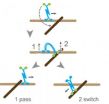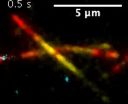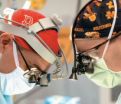(Press-News.org) Researchers at Warwick Medical School have shown for the first time how a protein motor, Kif15, uses acrobatic flexibility to navigate within the mitotic spindle. Understanding how it works could prove vital for the development of targeted cancer therapies.
The new study, published in eLife, describes the behaviour of Kif15 for the first time and provides a breakthrough step towards understanding the role it plays in cell division.
Many frontline cancer drugs target microtubules, the molecular cables that are used to build the mitotic spindle - the protein machine that drives equal separation of chromosomes during mitosis.
By breaking these microtubules, the uncontrolled multiplication of cancerous cells can be stopped. However, cells can become resistant to such drugs and as a result researchers are developing a new class of drug that targets the molecular motors – tiny protein machines that consume chemical fuel to walk along microtubules, move them around and organize them into the spindle.
One of these molecular motors, Kif11, is a key target for these drugs. Yet when Kif11 is inhibited, it is shown that cells are able to adapt and a second motor, Kif15, picks up some of the workload and enables the continuation of mitosis.
Previous research established that Kif11 is different to other kinesin protein motors, being referred to as a 'dumbbell' on account of having four limbs: allowing it to walk on microtubules and bind two microtubules together. During mitosis it slides these microtubules apart, a key process in cell division. The McAinsh lab at Warwick Medical School have now shown that Kif15 shares this four-limbed property, although it does not appear to be able to slide microtubules apart.
Dr McAinsh, said, "It's fascinating to see that Kif15 is also a dumbbell shape – but even more interesting are the differences between the two."
VIDEO:
This video shows how Kif15 effectively switches microtubules at intersections.
Click here for more information.
kifguide"Kif15 can actually switch between microtubules at intersecting points and therefore might be able to circumvent roadblocks or avoid traffic jams caused by other motors. It's the first motor protein we've seen using such a feature." (see video at bottom of release)
"We think that Kif15 switches between microtubules by using its additional two limbs: Where it encounters a track that it wants to move onto, it contorts and uses its two not yet attached limbs to grip the new track. In the most basic sense it starts to walk on its hands in a manner not too dissimilar to a circus acrobat."
Along with the ability to easily navigate the spindle, it also moves along microtubules some seven and half times quicker than Kif11 – at 150nm/s (nanometres per second) rather than 20nm/s.
Now that the team have identified how Kif15 behaves, it is hoped that it will allow for further understanding of the role that it plays in supporting cell division.
Dr McAinsh explained, "A greater knowledge of this protein motor will open the door to developing targeted therapies that can work towards simultaneously restricting both Kif11 and Kif15."
INFORMATION:The research was funded by Marie Curie Cancer Care.
Kif15: The acrobatic motor protein that could pave the way for new cancer therapies
2014-03-26
ELSE PRESS RELEASES FROM THIS DATE:
Parental addictions associated with adult children's arthritis
2014-03-26
The adult offspring of parents who were addicted to drugs or alcohol are more likely to have arthritis, according to a new study by University of Toronto researchers.
Investigators examined a group of 13,036 adults and found that 20.4 per cent of respondents had been diagnosed with arthritis by a medical professional. Investigators found that 14.5 per cent of all respondents reported having at least one parent whose drug or alcohol use caused problems while were under the age of 18 and still living at home.
Results indicate that individuals whose parents were addicted ...
Study finds secret to cutting sugary drink use by teens
2014-03-26
COLUMBUS, Ohio – A new study shows that teenagers can be persuaded to cut back on sugary soft drinks – especially with a little help from their friends.
A 30-day challenge encouraging teens to reduce sugar-sweetened drink use lowered their overall consumption substantially and increased by two-thirds the percentage of high-school students who shunned sugary drinks altogether.
The "Sodabriety" challenge, piloted by Ohio State University researchers, was an effort to confront the largest source of added sugar in the U.S. diet: sugar-sweetened soft drinks, sports and energy ...
Scientists track 3D nanoscale changes in rechargeable battery material during operation
2014-03-26
UPTON, NY-Scientists at the U.S. Department of Energy's Brookhaven National Laboratory have made the first 3D observations of how the structure of a lithium-ion battery anode evolves at the nanoscale in a real battery cell as it discharges and recharges. The details of this research, described in a paper published in Angewandte Chemie, could point to new ways to engineer battery materials to increase the capacity and lifetime of rechargeable batteries.
"This work offers a direct way to look inside the electrochemical reaction of batteries at the nanoscale to better understand ...
New clue to autism found inside brain cells
2014-03-26
The problems people with autism have with memory formation, higher-level thinking and social interactions may be partially attributable to the activity of receptors inside brain cells, researchers at Washington University School of Medicine in St. Louis have learned.
Scientists were already aware that the type of receptor in question was a potential contributor to these problems – when located on the surfaces of brain cells. Until now, though, the role of the same type of receptor located inside the cell had gone unrecognized. Such receptors inside cells significantly ...
Counting calories in the fossil record
2014-03-26
Starting about 250 million years ago, at the end of the Permian period, brachiopod groups disappeared in large numbers, along with 90 percent of the planet's species. Today, only a few groups, or genera, of brachiopods remain. "Most people won't be familiar with brachiopods. They're pretty rare in the modern ocean," said Jonathan Payne, a paleobiologist at Stanford University.
Meanwhile, bivalves flourished, diversifying into a staggering variety of shapes and sizes, and spread from marine to freshwater habitats. "After the end-Permian mass extinction, we find far fewer ...
Last drinks: Brain's mechanism knows when to stop
2014-03-26
The study found a 'stop mechanism' that determined brain signals telling the individual to stop drinking water when no longer thirsty, and the brain effects of drinking more water than required.
Researcher Professor Derek Denton from the Faculty of Medicine, Dentistry and Health Sciences at the University of Melbourne said the study provided insight into the human instincts that determine survival behaviour and are also of medical importance.
"Different areas of the brain involved in emotional decision-making were activated when people drank water after becoming ...
Two spine surgeons are 3 times safer than 1
2014-03-26
Seattle, WA—A new team approach has improved safety—reducing rates of major complications by two thirds—for complex spinal reconstructive surgery for spinal deformity in adult Group Health patients at Virginia Mason Hospital & Seattle Medical Center. An article in the March issue of Spine Deformity gives a detailed description of the standardized protocol before, during, and after the surgery, stressing the new approach's three main features:
Two spine surgeons in the operating room
A live preoperative screening conference
Monitoring bleeding during the operation
The ...
ATHENA desktop human 'body' could reduce need for animal drug tests
2014-03-26
Creating surrogate human organs, coupled with insights from highly sensitive mass spectrometry technologies, a new project is on the brink of revolutionizing the way we screen new drugs and toxic agents.
ATHENA, the Advanced Tissue-engineered Human Ectypal Network Analyzer project team, is developing four human organ constructs – liver, heart, lung and kidney – that are based on a significantly miniaturized platform. Each organ component will be about the size of a smartphone screen, and the whole ATHENA "body" of interconnected organs would fit neatly on a desk.
"By ...
Life expectancy gains elude overweight teens
2014-03-26
Washington, DC—Although people live longer today than they did 50 years ago, people who were overweight and obese as teenagers aren't experiencing the same gains as other segments of the population, according to a new study published in the Endocrine Society's Journal of Clinical Endocrinology & Metabolism (JCEM).
The life expectancy of the average American born in 2011 was 78.7 years, according to the U.S. Centers for Disease Control and Prevention. The average lifespan has increased by more than a decade since 1950, but rising obesity rates threaten to take a toll on ...
Sugary drinks weigh heavily on teenage obesity
2014-03-26
New research shows sugary drinks are the worst offenders in the fight against youth obesity and recommends that B.C. schools fully implement healthy eating guidelines to reduce their consumption.
Data from the 2008 Adolescent Health survey among 11,000 grade seven to 12 students in British Columbia schools indicates sugary drinks like soda increased the odds of obesity more than other foods such as pizza, french fries, chips and candies.
The study, published today in the International Journal of Behavioral Nutrition and Physical Activity, found that students in schools ...







